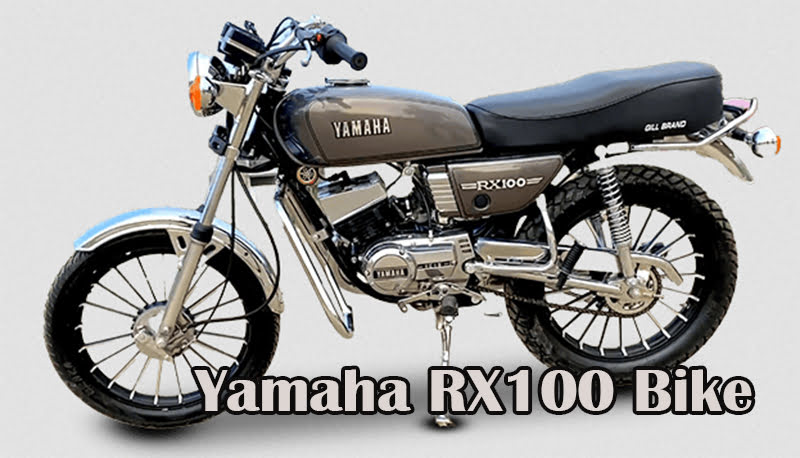Yamaha RX100 Bike – The iconic Yamaha RX100 is making a powerful comeback with a bold design, strong engine, and budget-friendly pricing. First launched in 1985, the RX100 became a cultural symbol in India due to its thrilling performance, lightweight frame, and signature two-stroke sound. Its 98cc engine and nimble handling offered unmatched riding joy. Even today, it’s a collector’s dream.
Yamaha RX100 Bike
The Yamaha RX100 an elegantly vintage thread in the vast tapestry of India’s motorcycling history—continues to evoke nostalgia decades after its production ceased. Revered not only as a commuter but as a cultural icon, the RX100 is set to return, and the buzz surrounding its relaunch is palpable. Until then, the Indian two-wheeler market was dominated by utilitarian commuter bikes and niche players like the Royal Enfield Bullet.
From Legend to the Birth
The Yamaha RX100’s arrival in India in 1985 was a turning point in the nation’s automotive timeline. Amidst a wave of economic reforms and a growing middle class hungry for accessible, exciting mobility, Yamaha—through a strategic collaboration launched what would become a game-changer.
Read More:- Bajaj Avenger 400 Bike
Engineering Excellence
At the core of the RX100’s appeal was its beautifully engineered heart—a 98cc, two-stroke, air-cooled SOHC single-cylinder engine. Producing around 11 bhp at 7,500 rpm and 10.39 Nm of torque at 6,500 rpm, it was a revelation for Indian riders in the 1980s. Equipped with Yamaha’s signature torque induction system, the RX100 delivered power seamlessly across the rev range.
The Heart of the Beast
The two-stroke design ensured an impressive power-to-weight ratio and a throttle response that was instantaneous and addictive. A 4-speed constant mesh transmission translated that power efficiently to the wheels, while its lightweight body—just 103 kg dry—and a compact 1230 mm wheelbase provided agile and responsive handling. Telescopic front forks and rear swingarm suspension with dual shock absorbers offered a poised and balanced ride.
The Best Riding Experience
To ride the RX100 was to experience something visceral. Starting the engine was a ritual—kick-starting the bike would awaken its smoky, two-stroke idle note, setting the tone for the ride ahead. Once in motion, the real magic happened around 3,000 rpm as the powerband kicked in. Acceleration was astonishing for its size, with a 0-60 km/h time of about 7 seconds. The engine’s signature chirping crescendo built into a “braaap” with every throttle twist—an acoustic hallmark that enthusiasts still recognize before even seeing the bike.
Read This:- Bajaj Platina 110
Historical Significance
Beyond engineering, the RX100 became a symbol of youthful independence and rebellion in 1980s and 90s India. It was a mark of aspiration and personal freedom in cities and small towns alike. It wasn’t just transportation—it was attitude on two wheels. Its simplicity also gave rise to a thriving modification culture, with aftermarket exhausts, ported engines, and aesthetic tweaks transforming RX100s into personal expressions of style and performance. That culture still thrives today.
The Collector’s Secret: Increase of Value & Rarity
Now a bona fide collector’s item, the RX100’s market value has soared. Clean, restored models can fetch prices exponentially higher than their original cost. With original parts becoming rare, a niche industry has emerged to restore and preserve these icons. Early models with boxy headlamps and factory paint schemes are especially coveted. But for collectors, it’s not just about money. The RX100 is an emotional investment a tangible connection to a cherished past.
Legacy & Modern Legacy
Though Yamaha no longer produces the RX100 in its original form, the spirit of the motorcycle lives on. Its essence—lightweight, responsive, fun-to-ride performance can still be felt in Yamaha’s modern bikes and in competitors’ retro-styled offerings. Strict emissions regulations make a direct reproduction of the two-stroke RX100 unfeasible today, but its legacy continues to inspire new designs and rekindle old passions.
Also Check:- Yezdi Adventure Bike
A Two-Stroke Icon that is Forever Timeless
What sets the Yamaha RX100 apart is its ability to transcend generations. Riders who once raced through city streets on its slender frame still recall the smell of two-stroke oil, the feedback from the handlebars, and the unmistakable sound of its engine. Even among today’s youth many of whom never rode one the RX100 commands admiration. In a world rapidly embracing electrification and automation, the RX100 represents something rare: an honest, emotional, analog experience that feels alive.
FAQ’S About Yamaha RX100 Bike
Is The Yamaha RX100 Coming Back?
Yes, Yamaha is reintroducing the RX100 with modern updates.
What Engine will The New RX100 Have?
It’s expected to feature a refined, eco-compliant engine, possibly four-stroke.
Will The RX100 Keep Its Classic Design?
The new model will retain retro styling with modern touches.
Conclusion
The Yamaha RX100 remains a legendary icon in India’s motorcycling history—renowned for its raw performance, distinctive sound, and emotional connect with riders. Its upcoming revival promises to merge nostalgic design with modern engineering, offering a ride that honors its legacy while meeting today’s standards. As the RX100 prepares to return to the streets, it is set to inspire a new generation while reigniting memories for long-time enthusiasts.
